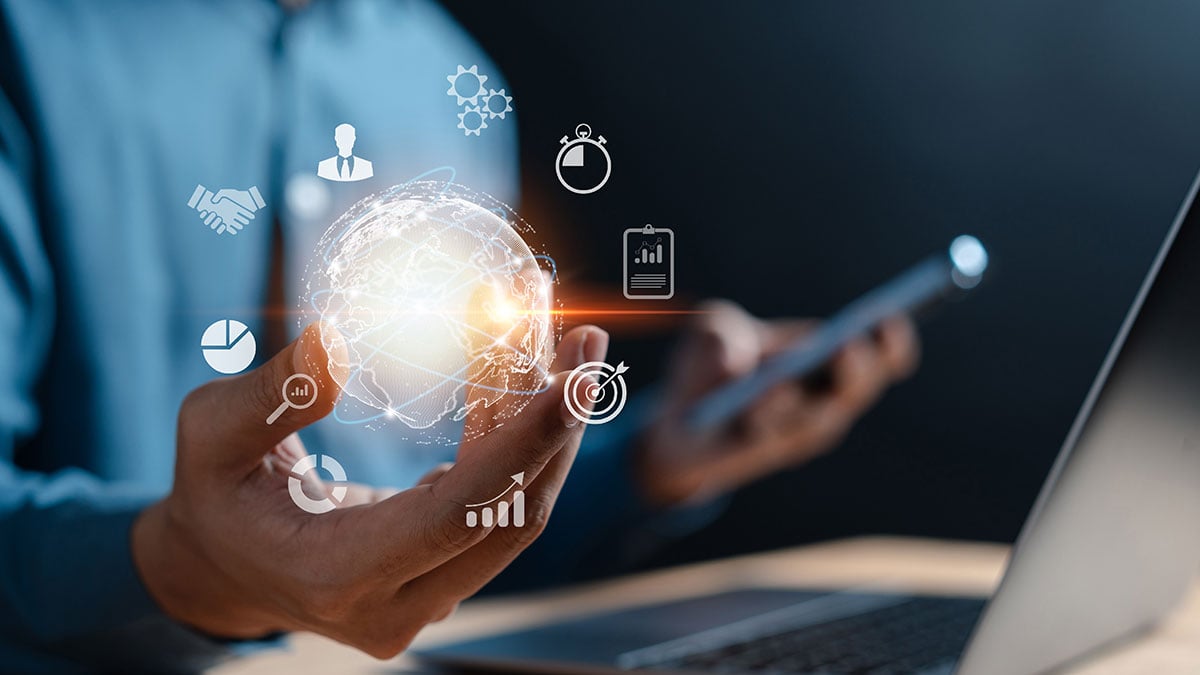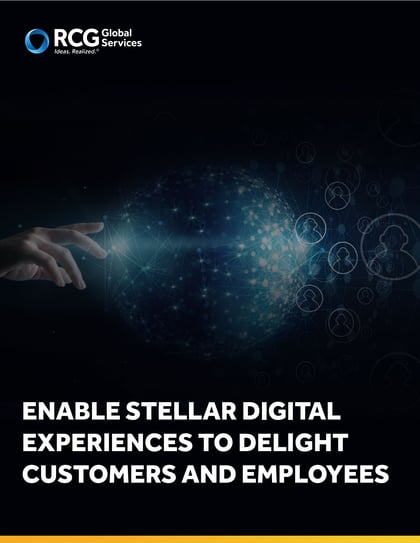Enable Stellar Digital Experiences to Delight Customers and Employees
How will the experience of your customers and employees shape your organization’s digital future? How will you create an experience that stands out amongst the rest?
The Customer Experience - Retaining Brand Allegiance

For many businesses, their speed and ability to move all, or a portion, of their services online was make or break for their success. To top it off, consumers began exploring new brands—citing value, quality, and brand purpose as top reasons for trying new brands across countries, according to McKinsey.
As we move into 2022, the pressure on businesses to respond quickly to consumer needs still remains. In fact, even a single bad experience can cause people to walk away from brands they love entirely.
“In the U.S., even when people love a company or product, 59% will walk away after several bad experiences, 17% after just one bad experience.” –PwC
So how do brands retain (or in some cases regain) brand loyalty post-pandemic?
Customer Experience Platforms and Tools

In 2022, businesses who wish to stay ahead will make CX a primary focus. Thankfully, with the use of predictive analytics, consumer needs are easier to track and gain insight from.
“Designing customer experiences is getting easier with the rise of predictive analytics.” –McKinsey Quarterly
Survey-based measurement systems, which were once standard for measuring CX, are proving to no longer meet the demands of today’s companies.
Instead, McKinsey cites other methods of data collection that will be more effective in providing strategic insights on CX, including:
- Internal data on customer interactions, transactions, and profiles
- Third-party data sets that cover customer attitudes, purchase behaviors and preferences, and digital behaviors, including social-media activity;
- New data sets on customer health, sentiment, and location (in stores, for example) generated by the Internet of Things (IoT).
The following platforms and tools can assist your business in keeping track of customer data and ultimately creating a unique customer experience for each individual customer.
Customer Data Platforms
Customer Data Platforms (CDPs) aggregate customer data across a variety of touchpoints into individual customer profiles. In addition to identity data (name, age, gender, location, contact information, etc.), CDPs also collect behavioral data (number and type of transactions made, email opens and clicks, online activity, etc.) and qualitative data (i.e. How did you hear about us? How would you rate this product?). This data is then aggregated autonomously into individual customer profiles, which businesses can use to gain personalized insights into each of their customers.
“Customer Data Platforms deliver the immediacy, accuracy, and unity that we need to keep aligning our organizations, inspiring our marketing, and engaging our customers.” – HubSpot
Benefits
✔ Complete 360° view into each customer
✔ Unified customer experience across all channels (physical and online)
✔ Easily accessible without tech expertise
✔ Democratized data, allowing every department access
A CDP creates a comprehensive and unified view of each customer by capturing and integrating data from multiple systems, linking information related to the same customer, and storing the information to track behavior over time.
Service Desks
Service desks manage tickets, tasks, and communications between customers and an organization, all in one place. Service desks act as a single source of truth, providing a place where multiple communications can be accessed in one central hub. Through automation, collaborative “shared inbox” features, and a set of customer self-service tools, service desks allow your organization to manage a high volume of customer queries quickly and efficiently.
Benefits
✔ Centralized location for all customer service communications
✔ Consistent customer experience across every channel
✔ Automated prioritization of tasks
✔ Problem management analytics and insights
Customer Intelligence Platforms
Customer Intelligence Platforms (CIP) leverage AI and machine learning to transfer raw data into useful insights about customer characteristics and behaviors. By supplementing customer web visit data with external information, CIPs can give retailers insight into customer characteristics and behaviors before they’ve ever made a purchase. The speed in which CIPs’ AI technology can analyze data from multiple sources is unmatched by humans.
Benefits
✔ Enriched customer data from various sources
✔ Automated audience segmentation
✔ Individualized experiences for each customer
✔ Automated high-speed data analysis
A 360° View of Customer Needs
Through improved analytical insights, businesses will be able to better predict, observe, and adapt to customer needs.
“Artificial intelligence (AI) and internet of things (IoT) platforms have been enthusiastically adopted in marketing, product design, and customer services, primarily because they enable businesses to improve the experiences we have when engaging with brands or using their products or services.” – Forbes
EXAMPLE
RCG worked with an Insurance organization that was in need of a trusted foundation of Customer Data for Marketing. By consolidating their customer data and enriching it with third-party demographic data, we were able to help them better analyze their customer base and generate high-probability cross and upsell leads for their agents.
Related Resources
Customer Experience Strategy & Roadmap
.jpeg?width=2000&height=1125&name=AdobeStock_481214335%20(1).jpeg)
By nature of this, there is no one-size-fits-all solution—the tactics you deploy will be specific to your audience and dependent on the consumer insights you’re able to obtain. Defining and establishing systems in your organization for implementing data-informed changes will be critical in carrying out a successful CX strategy.
Step 1: Determine who will take ownership of CX initiatives.
For large organizations, building out a core CX leadership team to define and lead your company’s CX initiatives will be critical. Getting buy-in and holding teams accountable will also be a key role for a CX leader.
Step 2: Determine a data collection process.
Implementing a successful CX strategy requires setting up systems across the organization. Leadership should determine which tools and platforms they’ll use, as well as which data sources they’ll rely on.
Step 3: Inform and educate internal stakeholders.
CX is not simply a marketing play. It’s critical that tech teams are involved too. The CX leadership team should clearly communicate the importance of CX initiatives, what role each internal team will play, and how information will be shared across teams.
Step 4: Prioritize goals.
Implementing a strong CX strategy doesn’t happen overnight. Leaders should determine major customer pain points and opportunities and find a way to address those first. Prioritizing a few, focused goals to start will set a solid foundation for expanding CX initiatives in the future.
The Importance of Personalized Customer Experiences

Especially in today’s climate, consumers are looking to do business with companies that offer an easy, convenient, and tailored experience. CX platforms, such as CDPs, service desks, and CIPs, help your organization build individual profiles for each customer, allowing them an experience that feels personalized to them.
The “Small Business” Experience
The small business experience is an attractive one to customers because they have the experience of being “known” by the staff. In the world of retail, for example, a staff member may guide a customer toward a specific product they know they’ll love, while offering specific, expert advice on discerning the use of the product. With the aid of CX tools, large companies can use customer data to mimic this kind of personalized experience for their customers virtually.
EXAMPLE
[In working with a Healthcare company, RCG developed a model which utilizes pharmacy information and patient characteristics to predict patient non-adherence of prescribed medical regimens. We then created frameworks that address a spectrum of at-risk conditions: readmissions, mortality, and other health quality metrics.]
“Increasing levels of personalization are going to be a very strong trend this year, with brands getting to grips with the idea of using technology to develop closer and more personalized relationships with their customers at scale.” – Forbes
The Employee Experience

The Rise of Remote
When it comes to remote work, the pandemic turned what was an emerging trend into status quo for many businesses. Since then, employers have found productivity largely unaffected (or in some cases improved) by remote work, with many choosing to keep employees remote, or implement a hybrid remote/in-office work model.
“More than 20 percent of the global workforce (most of them in high-skilled jobs in sectors such as finance, insurance, and IT) could work the majority of it’s time away from the office—and be just as effective.” – The McKinsey Global Institute (MGI)
Yet the switch to remote did not happen seamlessly overnight. Companies had to adapt to virtual collaboration, process shifts, and changes in company culture. For companies who had already invested in digital transformation, this transition was easier. For late adopters, the shift exposed weak spots that needed to be addressed—resulting in the need for digital acceleration.
With The Great Resignation on the rise, attracting and retaining employees is more important now than ever.
How will companies meet the challenge of improving employee experience in an accelerated digital world?
Employee Experience Platforms and Tools
Employee experience (EX) refers to feelings and opinions employees have toward their experiences at work—the whole picture. Before they are even hired, employees begin forming their impressions of their employer through the company’s online presence and their interview experience. Once hired, their perceptions continue to evolve as they engage with company processes, technologies, coworkers, and leaders. In a digital landscape, having access to the tools required to do their jobs effectively is critical and influences their everyday work experience. In today’s world, companies must not only adopt digital strategies quickly and effectively, but be on a digital acceleration trend to ensure employee retention and attraction.
Security by Default
Security concerns can be a barrier for businesses embracing a digital future, as they prevent non-technical users from integrating data sources. As MuleSoft puts it, “development platforms must be secure out-of-the-box. That means if there are a range of configuration options, the most secure ones are offered by default—so that users must proactively choose less secure ones.” With better protection from the risk of API attacks, businesses are not held back from technical innovations that benefit their employees.
Benefits
✔ Prevents cybersecurity defects
✔ Enables employees to use platforms they’re already familiar with but previously posed too much security risk
✔ Employees don’t have to worry about causing an accidental security breach
✔ Increased employee trust allows employees more autonomy and freedom
Multi-Cloud Services
Cloud platforms such as Amazon Web Services (AWS), Microsoft Azure, and Google Cloud enable complex business models to achieve their goals with more ease than ever before while also allowing for faster technology development. And with the rising popularity of cloud-based apps, a new approach to managing your cloud is now needed. A well-oiled, transparent approach to managing operations is critical for businesses wanting to gain the most out of their cloud journey. With a multi-cloud approach, businesses can leverage two or more platforms to get the optimum mix of benefits from multiple resources.
Benefits
✔ Gives employees access to a wider range of tools
✔ Eases learning curve for platform adoption
✔ Improves IT agility and enables IT to be more responsive to business needs
Steps to a Successful Cloud Migration
- Plan Your Migration
Set a clear strategy, map out a realistic project timeline, and limit the number of variables and dependencies for transitioning on-premises applications to the cloud.
- Inventory Your Assets
Build a holistic view of your data center assets, IT portfolio, and their relationship to specific cloud assets and services.
- Forecast Your Cloud Costs and Calculate Your ROI
Consider the costs for the cloud infrastructure and the engineering involved in moving and storing your data and applications.
- Ensure Compliance and Security
Review the numerous regulations that you must follow when moving to the cloud. These are particularly important if your business is in healthcare or financial services.
EXAMPLE
[RCG developed a Data Lake-as-a-Service on Azure with StreamSets, Cazena, and Cloudera to support IoT data pipelines for 1M US cars. In migrating their system to the cloud, we were able to increase data literacy, improve data availability, and enable advanced analytics and data science for customers and their cars.]
Single Source of Truth
With data as a key driver of customer satisfaction, it’s critical employees have access to the data they need to make critical improvements and strategic decisions. Employees need access to consumer data from multiple sources that is accurate and up-to-date. By creating a single source of truth (SSOT), or a central place where all company-wide data can be accessed, employees are better equipped to leverage key insights.
Benefits
✔ Simplifies and streamlines onboarding
✔ Ensures employees find correct information when they search independently
✔ Accurate, up-to-date information is accessible across departments and teams
Setting Them Up for Success
At the core of building a positive employee experience is setting employees up with the right tools they need to be successful in their roles. With better access to accurate information and a broader range of platforms and tools, employees are able to make quicker, more informed decisions independently. This boosts employee morale, prevents rework, and eliminates the frustrations that can result from information silos and miscommunications.
Employee Experience Strategy & Roadmap

Step 1: Ensure appropriate collaboration tools are in place.
Video conferencing software, project management platforms, and easy file sharing are a few of the foundational tools to successful collaboration amongst employees. In addition to these communication tools, it’s important the right tools are leveraged for data collection, marketing initiatives, and customer management.
Step 2: Review EX metrics.
Reviewing key indicators of employee engagement and satisfaction will give business leaders a starting point for setting EX goals. Employers can gain valuable insights by reviewing productivity levels, the quantity of time-off and sick requests, and how employees are doing outside of the workplace. When surveying employees directly, it’s important to do so at every stage of the employee lifecycle, from recruitment and onboarding to training and development. Tools like HRMS (human resource management software) or HCM (human capital management) solutions can serve as a central place to view feedback and track key metrics.
Step 3: Set goals and implementation strategies.
Once you have a sense of employee pain points, set clear goals for what you want to achieve first. If it’s a better onboarding or training experience, consider investing in onboarding or training software that can automate some of the process. Remember that just like with customers, employee-needs adapt and change overtime. Continual review of EX data and goals will be critical to keep employees happy long-term.
The Importance of Personalization in EX
Just like CX, personalization is a key component of implementing a strong EX strategy. At the core, employees want to feel heard, seen, and ultimately valued. Employees should have regular check-ins with management and be celebrated and acknowledged for work well done. Journey mapping is one way to uncover EX issues and solutions. By mapping out each stage of an employee’s path, from recruitment to present, you can begin to see gaps from their perspective. Technology can play a role in the personalization of EX, as well. Employee engagement apps and internal communication platforms help simplify communication and allow employees to receive targeted and timely information.
Looking to the Year Ahead
As we look to 2022, the technologies organizations choose to embrace or ignore will come to define their success. But how will they make such pivotal decisions? The answer is simple: by listening and responding to the human need for connection.
Customers and employees are the same in their desire to be heard and understood. To this end, customization and personalization will be at the core of every successful business strategy. Implementing this high level of personalization will require robust data management, AI technology, and fully integrated and engaged teams.
How ready is your business to embrace CX and EX?
RCG Can Help
RCG has focused expertise in helping companies achieve their digital transformation and digital acceleration goals, and we’ve accumulated a great deal of experience in collaborating and achieving successful transformations. RCG has real-world experience with client companies from around the globe and can help you to personalize and streamline your journey to hyper business in 2022.
Works Cited
- https://www.mckinsey.com/business-functions/marketing-and-sales/our-insights/prediction-the-future-of-cx
- https://www.informatica.com/resources/articles/customer-intelligence-platform-importance.html
- https://blog.hubspot.com/service/service-desk
- https://blog.hubspot.com/service/customer-data-platform-guide
- https://www.mckinsey.com/business-functions/marketing-and-sales/our-insights/a-global-view-of-how-consumer-behavior-is-changing-amid-covid-19
- https://www.mckinsey.com/business-functions/marketing-and-sales/our-insights/prediction-the-future-of-cx
- https://www.forbes.com/sites/bernardmarr/2021/11/17/the-5-biggest-customer-experience-cx-trends-in-2022/?sh=2e1ad8f94cff
- https://www.accenture.com/us-en/insights/interactive/business-of-experience?c=acn_glb_businessofexpergoogle_11656741&n=psgs_1120&gclsrc=ds
- https://www.mckinsey.com/featured-insights/leadership/the-next-normal-arrives-trends-that-will-define-2021-and-beyond
- https://www.zendesk.com/blog/why-companies-should-invest-in-the-customer-experience/
Download a PDF version of this guide by filling out this form



